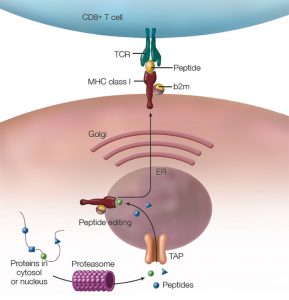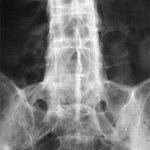
(click for larger image)
Figure 1: The MHC Class I Antigen Presentation Pathway: TCR = T cell receptor, b2m = beta 2 microglobulin, ER = endoplasmic reticulum, TAP = transporter associated with antigen processing.
Brook Coppola
The mechanistic link between human leukocyte antigen B27 (HLA-B27) and ankylosing spondylitis (AS) is one of the great enigmas in rheumatology. The introduction of biological therapies that target tumor necrosis factor (TNF) or the interleukin (IL) 23/IL-17A axis has had a major impact on the quality of life for many patients with AS, and one might ask: Why should we care about HLA-B27 at all?
Inhibitors of TNF or the IL-23/IL-17A axis are broadly effective in AS. However, they expose patients to the risks of chronic immunosuppression and place a substantial financial burden on the healthcare system. The focus of research, therefore, has to shift toward finding a cure or preventing the disease, which is unlikely to happen without a detailed understanding of the role of HLA-B27 in AS pathogenesis.
This article provides an overview of HLA-B27 research, highlighting important historical landmarks and recent advances.
Discovery of the HLA-B27 Association
In the early 1970s, serological methods originally developed for histocompatibility testing in the organ transplantation field were applied to rheumatic diseases. This resulted in the discovery of the association between HLA-B27 and AS in 1973 by groups in Los Angeles and London.1-3 Subsequently, HLA-B27 was shown to be associated with other types of spondyloarthritis (SpA) or SpA-related disorders as well, namely psoriatic arthritis, reactive arthritis and uveitis.4-7
HLA testing at that time was done with sera from multiparous women, who had become immunized against paternally derived antigenic determinants present on cells of the fetus.
The nature of the antigenic targets remained unknown until the mid-1980s, when the sequences of the HLA genes, including HLA-B27, were determined.8,9 Soon thereafter, it was discovered that the serologically defined HLA-B27 entity was in fact a family of related alleles with minor differences in their amino acid and/or nucleotide sequences and that some of these subtypes were not associated with AS (see below).
MHC Class I Antigen Presentation
HLA-B27 is an allelic variant of the HLA-B gene located in the major histocompatibility complex (MHC) on human chromosome 6p21. The MHC is a highly polymorphic region containing many genes involved in adaptive and innate immunity. HLA-B and the closely related HLA-A and HLA-C genes are located in the class I subregion of the MHC. HLA-A, HLA-B and HLA-C encode the heavy chain (HC) component of MHC class I molecule. MHC class I molecules are heterotrimeric complexes of the highly polymorphic HC, the non-polymorphic beta 2 microglobulin (b2m), which is encoded outside the MHC on chromosome 15, and a peptide of 8–9 amino acid length. The peptide lies in a groove formed by two HC alpha helices on the apical surface of the complex.


